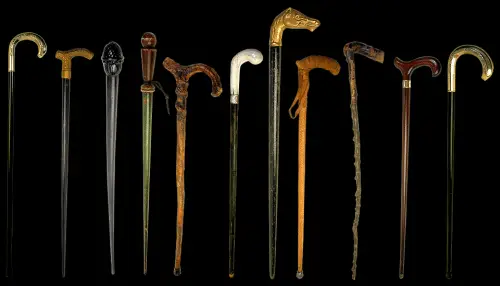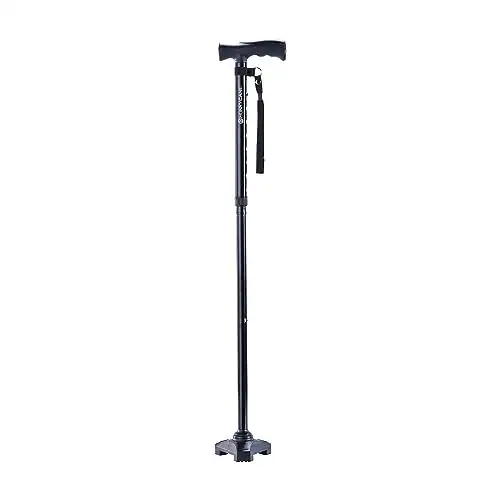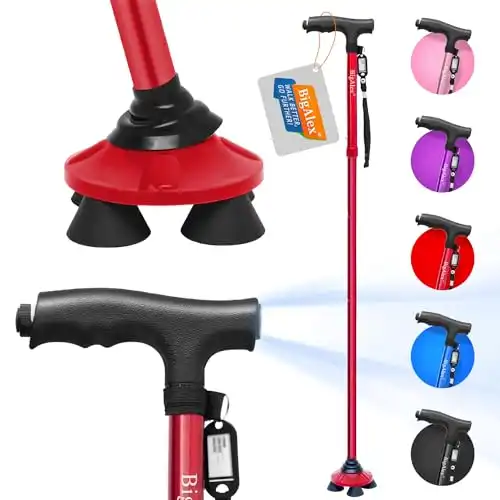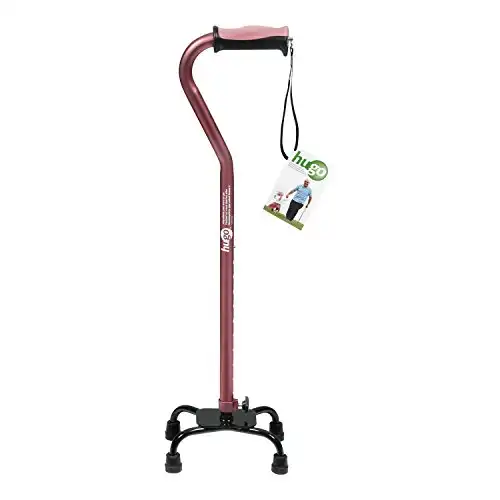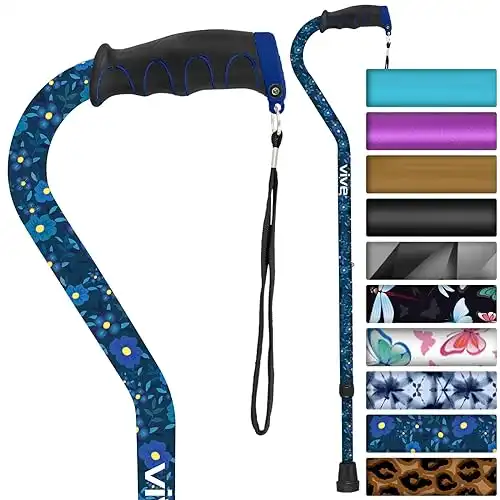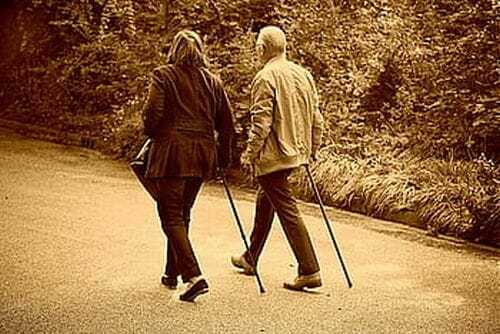Unequivocally, canes help with balance as they provide an additional touch-point for your body to the floor, which helps you in maintaining balance and walking with confidence. Balance problems occur typically because of four reasons:
- Lack of strength in muscles and joint-related problems
- Decreased coordination
- Vestibular dysfunction
- Poor eyesight
A cane can help in all four of these problem areas. By adding a touchpoint, it can help reduce the risk of bumping into objects due to poor vision. It also acts as an additional support mechanism for weak muscles and joints.
A solid grip on the cane can help improve coordination issues and managing vestibular dysfunction as well. Sometimes a cane may be required only for a short period whereas in other cases, they may be required permanently to help walk properly.
In this article, we review some of the best canes for balance problems. The table below provides a quick snapshot of the top picks, and we go into more discussions and details further down.
|
Height adjustability:
30.5 -37.5 inches
|
Height adjustability:
40 - 49 inches
|
Height adjustability:
30-35 inches and 33-38 inches
|
Height adjustability:
28-39 inches
|
Height adjustability:
29-38 inches
|
Contents
What to Consider When Buying a Cane for Balance Problems
Number of Touch-points
While most standard canes come with only a single touchpoint to the floor, there is a separate type of cane called the quad cane that has four touchpoints with the ground. As a result, these are more stable and provide a better balance than a single touchpoint cane.
Quad canes are heavier than single point canes and take a bit of getting used to, whereas single touchpoint canes are fairly easy to use and can be used by almost anybody.
Using the Right Grip
Another important feature to consider when buying a cane is the grip at the top of the cane. A good rule of thumb is that the grip should not cause numbness or pain in the hand after using it for 2-3 hours.
Most people prefer a grip that has thick padded foam, while others are comfortable enough with the stable security of a rubberized grip.
If you or your loved one is facing issues with dexterity in your hands such as with arthritis or joint pain, it would be advisable to look at a cane with a grip that is large enough in size so that it is comfortable for you to hold.
You may also like Best Crutches for Long Term Use
Height Adjustability
The height of the cane should be suitable for your height. A good yardstick is that, in a standing position, the cane should cause your elbow to be rotated by no more than 15 degrees.
Another way to look at it is that with your arms by your side the cane should not be taller than your wrist height. If the cane is any taller than this it would be difficult for you to hold and would cause pain in your shoulders as well as the elbow.
If it is any shorter than this, you would have to bend down to hold the cane properly and it may cause pain in the spine, neck, and back.
Rubber Tip
The cane should have a good quality rubber tip at the bottom touchpoint with the ground. It is essential to have a good rubber tip because it creates stability and enhances the grip of the walking cane.
If you find that the rubber tip of your cane is worn down and the tread is not in good shape, you should immediately look at replacing at.
Weight Capacity
Make sure that the cane is strong enough to support your weight. Most canes are capable of supporting up to 500 pounds of weight, however in case you or your loved one is larger, you should look at buying a cane that is sturdy enough for you.
You may also like How to Prevent Stooping in Old Age?
How to Use Your Cane
The below steps are an essential guide for anyone who is using a cane for the first time:
- The cane should be used on the other side of the leg which is injured or painful due to muscle/joint problems.
- Put all weight on your good leg.
- Once your weight is comfortably supported by your good side, move the cane and the injured leg forward.
- Make sure that your cane is placed firmly on the ground, and is at a comfortable distance from your good leg. Do not take a step before you’re sure that your cane is firmly rooted on the ground.
- Using the cane and the weaker leg together to support your weight, move your good leg forward in line with your weaker leg.
While we are on it, the video below further shows how to use your cane properly.
Best Cane for Balance Problems
#1 – HurryCane Freedom Edition
The HurryCane is one of the best selling walking canes in the US, and for good reason. This walking stick feels like it is just an additional limb to the body. It is so comfortable to use and thoughtfully designed that you never feel like you are using an rehabilitation aid at all.
This device comes with a patented, three-tip bottom that provides additional stability and improves traction, thereby giving solid balance during both indoor and outdoor usage. It also has a unique bending capability, which emulates the human knee when standing up or sitting down.
This folding cane has one of the largest range of height settings, ranging between 30.5 inches and 37.5 inches. Not only this, but the cane also folds down to almost 1/3rd its size and easily fits in a glove compartment or even your pocket when folded down. Another great feature is that the cane stands erect when left alone, so that you do not need to worry about having to line it up against a wall when leaving it unused for a while.
With a solid weight carrying capacity of 350 pounds, the HurryCane is a vast improvement over the standard walking stick, and is therefore our top choice in this lineup.
Pros
- Unique 3 touchpoint base for extra stability
- Height adjustable between 30.5 inches to 37.5 inches
- that folds down to almost 1/3rd its size
- Ergonomically designed with a comfort fitting grip
- Unique bending action, just like a human knee
- Stands erect when left unattended
Cons
- The swivel motion of the cane requires a larger force to activate
- Handle quality could be better
You may also like Do You Need Crutches With a Walking Boot?
#2 – Campbell Posture Cane Foldable Walking Cane
This is a lightweight and strong cane made of high quality and durable materials that is easy to use and remains sturdy throughout its life. It is height-adjustable so that it can suit a variety of user heights. The cane is a self-standing one that has an accompanying stability tip with 360-degree traction rings.
The grip handle of the stick is ergonomically designed to eliminate downward pressure, which makes it very comfortable for your hand, wrist, and shoulder while walking. The handle is designed in such a way so that you are inclined to look up instead of downwards, thereby improving your line of sight and helping you walk upright, which helps improve posture as well as balance and reduces back shoulder and neck-related problems.
Pros
- Made of high quality and durable aluminum
- Self-stability tip
- Unique handle design which promotes upright walking
- 10 height adjustment settings
- 360-degree traction rings
Cons
- The unique handle may be more difficult to use for arthritic individuals
- The cane is fairly lightweight, so it may not provide as much support as other canes
#3 – BigAlex Folding Walking Cane
Just like the HurryCane walking stick, the BigAlex Folding Cane also has a 360-degree free rotation pivoting base made of four touchpoints, making it a quad cane.
The BigAlex uses an aluminum alloy ball head shaft to achieve a 360-degree rotation, which makes its base extremely durable. The cane is capable of supporting up to 300 pounds of weight and is intelligently designed for portability with a 12-inch folded span and included carrying bag.
The cane is capable of adjusting to five different height levels with the simple push of a button.
Another useful feature included with the cane is a high power LED light, which is useful for walking in the dark. 2 AA batteries are included in the package along with the cane.
Pros
- 360-degree pivoting quad cane
- 5 height adjustment levels, and two height ranges
- Aluminum alloy ball head shaft for long-lasting pivot
- LED light
- that folds to 12 inches and comes with a carrying bag as well
Cons
- The bottom tends to break out after a few months
- Stability is an area of concern
You may also like Best Upright Walkers for Seniors
#4 – Hugo Adjustable Quad Cane
The Hugo Adjustable Quad Cane is height adjustable between 28 to 39 inches, which is comfortable enough for most user heights. It has a special shock-absorbing handle that is ergonomically designed and comes included with a reflective strip that is useful to have when walking at night time.
The cane has 11 different height settings and can support weights up to 300 pounds. The rubber tips at the bottom are flared for extra stability and grip. The design of the cane makes it useable for both left and right hand.
Pros
- Height adjustable between 28 to 39 inches
- Ergonomically designed handle for easy grip
- Reflector strip for nighttime walking
- Flared rubber tips for extra support
- Useful for both the left and right foot
Cons
- Quite a few users gave complained that the cane was wobbly when used for a longer period
#5 – Vive Walking Cane
Last, but not the least, the Vive walking Cane uses an offset handle that redistributes weight across the base of the cane, thereby improving balance and reducing pressure on the wrist.
The cane has a slip-resistant rubber cane tip which provides for good stability on uneven surfaces.
It is made from a lightweight frame that uses anodized aluminum and is resistant to corrosion.
The Vive cane is height adjustable from 29 inches to 38 inches and supports weights of up to 350 pounds. The product has an unconditional lifetime guarantee from Vive.
Pros
- The handle distributes weight, thereby reducing pressure on the wrist
- Slip-resistant rubber cane tip improves traction on uneven surfaces
- Height adjustable between 28 inches to 39 inches
- Aluminum-alloy used for a lightweight and durable frame
- Lifetime unconditional guarantee
- The cane is available in beautiful colors and patterns
Cons
- The handle is bulky and not cushioned
- A few users have complained about shipping damages to the cane, so ensure the cane you receive is in new condition
You may also like Best Balance Board For Seniors
Frequently Asked Questions
Q. What can cause balance problems when standing or walking?
Balance problems can cause dizziness, unsteadiness, or lightheadedness. One might get the sensation that the room is spinning or that you may fall down. These feelings may occur even if your sitting or lying down.
Balance disorders may be caused by one or a combination of the following cases:
- Sense of motion or spinning. This may be caused by Benign paroxysmal positional vertigo, vestibular neuritis, persistent dizziness, Meniere’s disease, a migraine, head injury, or motion sickness.
- Feeling of faintness or lightheadedness. This can be due to postural hypertension or some form of cardiovascular disease.
- Loss of balance or unsteadiness. This may be a result of vestibular problems, nerve damage to the legs, or certain medications or neurological conditions.
- Dizziness, caused by inner ear problems, psychiatric disorders, hyperventilation, or certain medications.
If you are experiencing a regular balance problem paired with any of the aforementioned signs, consult your doctor.
Q. What are symptoms of a ?
The following are notable symptoms of having balance problems:
- Feeling of motion or spinning, even in absence of motion
- Faintness or lightheadedness
- Loss of balance or unsteadiness
- Feeling of falling or that you might fall
- Feeling a floating sensation or dizziness
- Changes to vision, such as blurriness
- Confusion
Q. Are there other tools I use to help with balance problems?
Besides using a cane to help with getting around, one might also consider one of the following walking aids:
- Crutches
- Walker
- Rollator walker
- Knee Scooter
- Wheelchair
- Mobility Scooter
Parting Words – A Stable, Staple Companion
Nearly 6% of the overall population[1] and more than 21% of people above the age of 65 years have an ambulatory disability or challenge walking in the US. A walking cane is an excellent device for anyone who is facing ambulatory difficulties due to balance-related issues in one foot. It can provide the necessary support and confidence needed for a person to overcome balance-related challenges, and it can also be used for rehabilitation during a recovery period.
A properly fitted walking cane with a good rubber tip and a strong grip provides an additional touch-point to the ground, thereby making the process of walking a lot easier and less painful.
In this article, we have reviewed some of the best walking canes available in the market for the purpose of providing stability and balance.
In our opinion, the The Original Campbell Posture Cane Foldable Walking Cane for Men and Women - FSA/HSA Eligible - Editorial Recommended - As Seen on TV is the best choice for a walking cane due to its 3 touchpoint base, its foldability, and its unique bending action. If you are looking for good value-for-money options, you can consider the BigAlex Folding Walking Cane with LED Light,Pivoting Quad Base,Adjustable Walking Stick with Carrying Bag for Man/Woman (Alloy Base), which offers solid stability at a nice price point.
While we make every effort to provide updated and correct information the advice given in this article and website should not be construed as medical advice. Please consult with your physician or medical practitioner before purchasing any ambulatory aid such as a walking cane. Each individual may have his or her own unique balance-related issues and your medical practitioner is the best person to decide which ambulatory support is the best to use in your particular case.
References:

